Psychology: Dual Process Model in Grief Coping Strategies
VerifiedAdded on 2023/01/17
|23
|7912
|44
Essay
AI Summary
This essay provides a comprehensive literature review of the dual process model for coping with grief. It begins by critiquing the shortcomings of traditional theories like the grief work hypothesis and introduces the dual process model as a more effective approach. The paper details the model's two main types of stressors: loss orientation and restoration orientation, and explains how individuals oscillate between these orientations to cope with grief. It explores the importance of understanding both stressors for effective grief counseling, highlighting the need for counselors to tailor their approach to the individual's needs, considering physical, mental, and emotional factors. The essay also acknowledges the model's limitations, particularly its failure to address situations involving severe stress, and emphasizes the need for further research to enhance its framework. Throughout the essay, the author synthesizes existing research to elucidate the model's components, including the stressors, cognitive strategies, and the dynamic process of oscillation. The essay underscores the importance of integrating coping strategies into daily life and the significance of counselors' understanding of detrimental and effective practices in the grief-coping process. Finally, the essay highlights the distinctiveness of the oscillation element, emphasizing its role in successful grief recovery and the need for time to relax and not think about the loss.
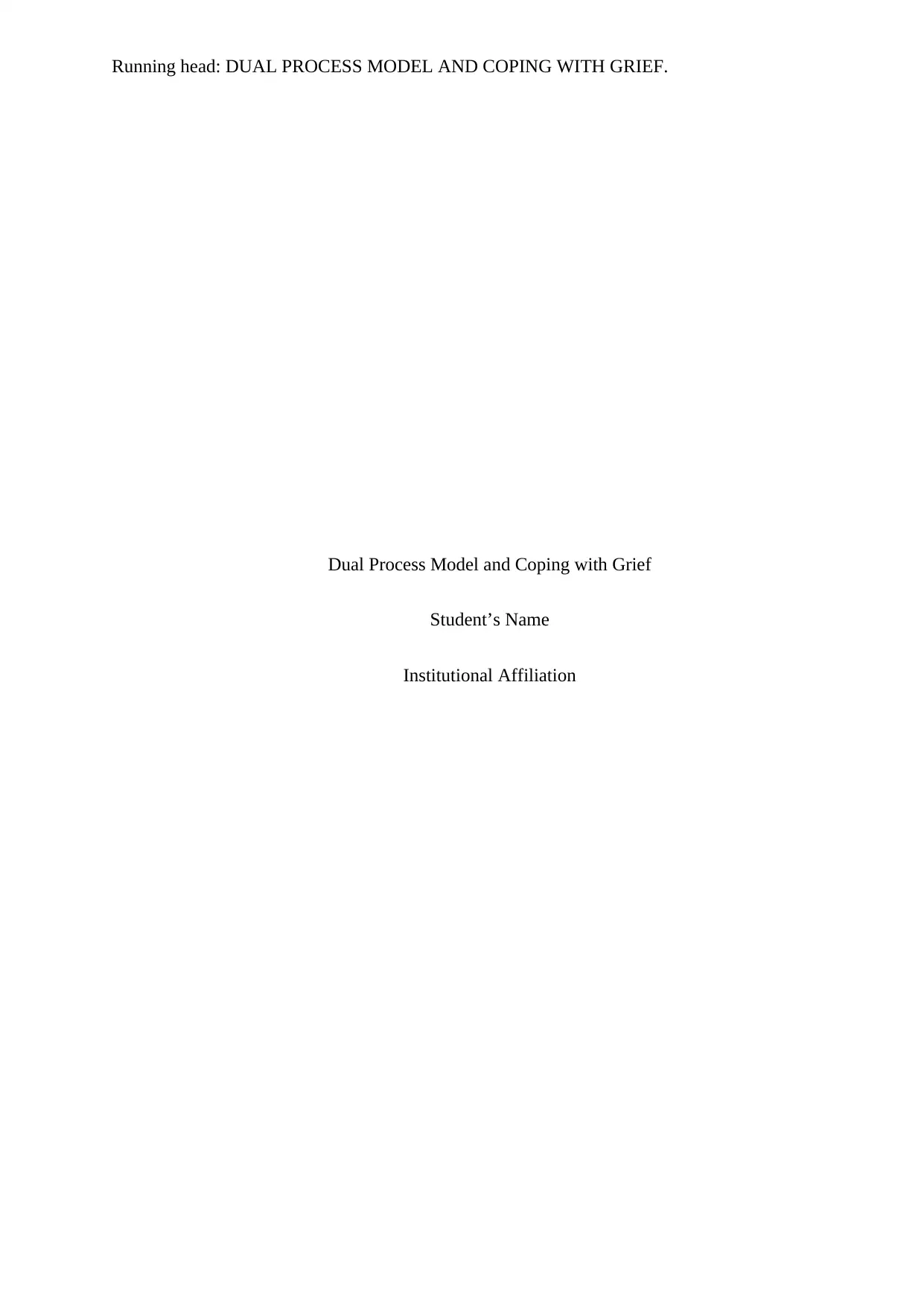
Running head: DUAL PROCESS MODEL AND COPING WITH GRIEF.
Dual Process Model and Coping with Grief
Student’s Name
Institutional Affiliation
Dual Process Model and Coping with Grief
Student’s Name
Institutional Affiliation
Paraphrase This Document
Need a fresh take? Get an instant paraphrase of this document with our AI Paraphraser
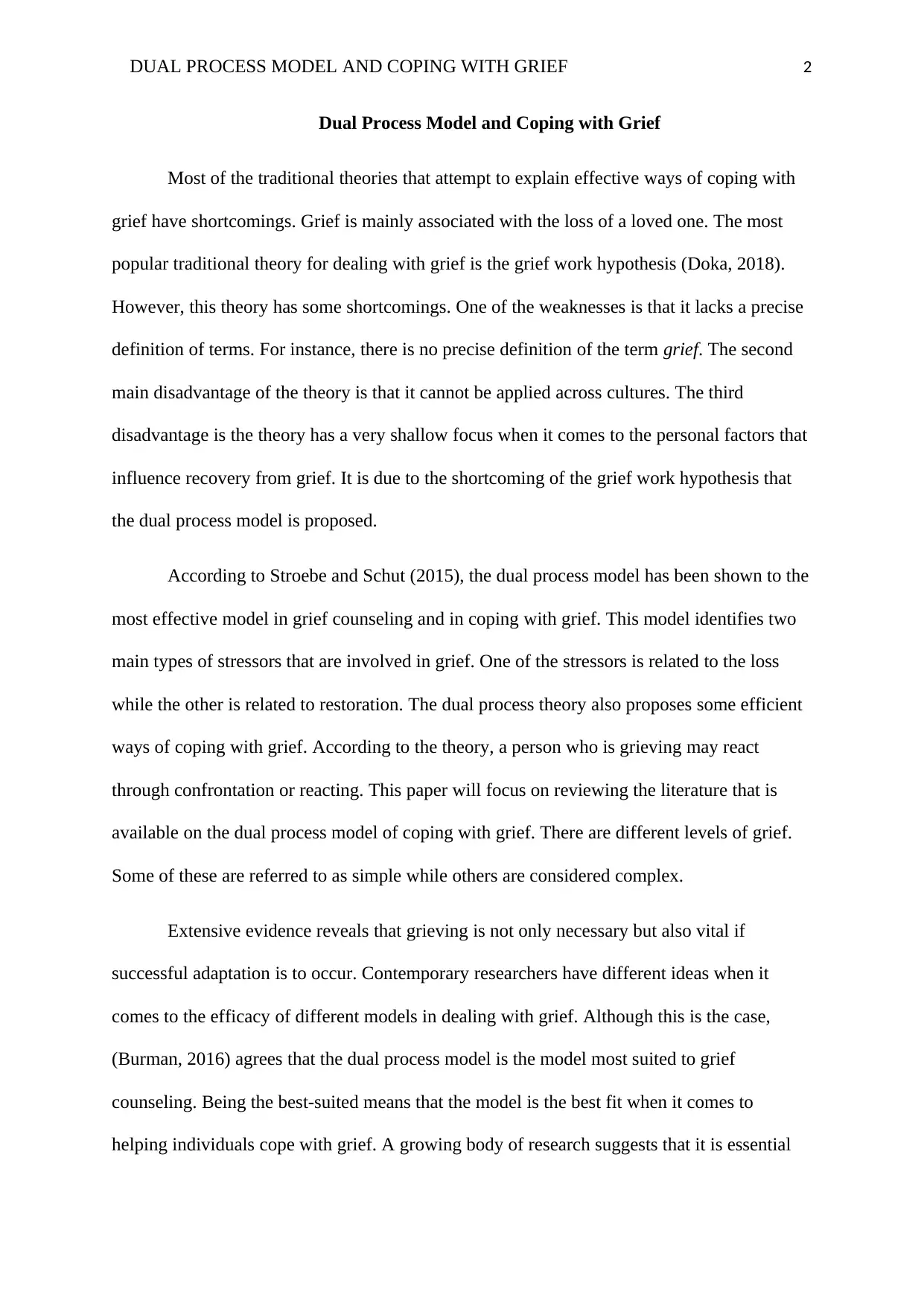
DUAL PROCESS MODEL AND COPING WITH GRIEF 2
Dual Process Model and Coping with Grief
Most of the traditional theories that attempt to explain effective ways of coping with
grief have shortcomings. Grief is mainly associated with the loss of a loved one. The most
popular traditional theory for dealing with grief is the grief work hypothesis (Doka, 2018).
However, this theory has some shortcomings. One of the weaknesses is that it lacks a precise
definition of terms. For instance, there is no precise definition of the term grief. The second
main disadvantage of the theory is that it cannot be applied across cultures. The third
disadvantage is the theory has a very shallow focus when it comes to the personal factors that
influence recovery from grief. It is due to the shortcoming of the grief work hypothesis that
the dual process model is proposed.
According to Stroebe and Schut (2015), the dual process model has been shown to the
most effective model in grief counseling and in coping with grief. This model identifies two
main types of stressors that are involved in grief. One of the stressors is related to the loss
while the other is related to restoration. The dual process theory also proposes some efficient
ways of coping with grief. According to the theory, a person who is grieving may react
through confrontation or reacting. This paper will focus on reviewing the literature that is
available on the dual process model of coping with grief. There are different levels of grief.
Some of these are referred to as simple while others are considered complex.
Extensive evidence reveals that grieving is not only necessary but also vital if
successful adaptation is to occur. Contemporary researchers have different ideas when it
comes to the efficacy of different models in dealing with grief. Although this is the case,
(Burman, 2016) agrees that the dual process model is the model most suited to grief
counseling. Being the best-suited means that the model is the best fit when it comes to
helping individuals cope with grief. A growing body of research suggests that it is essential
Dual Process Model and Coping with Grief
Most of the traditional theories that attempt to explain effective ways of coping with
grief have shortcomings. Grief is mainly associated with the loss of a loved one. The most
popular traditional theory for dealing with grief is the grief work hypothesis (Doka, 2018).
However, this theory has some shortcomings. One of the weaknesses is that it lacks a precise
definition of terms. For instance, there is no precise definition of the term grief. The second
main disadvantage of the theory is that it cannot be applied across cultures. The third
disadvantage is the theory has a very shallow focus when it comes to the personal factors that
influence recovery from grief. It is due to the shortcoming of the grief work hypothesis that
the dual process model is proposed.
According to Stroebe and Schut (2015), the dual process model has been shown to the
most effective model in grief counseling and in coping with grief. This model identifies two
main types of stressors that are involved in grief. One of the stressors is related to the loss
while the other is related to restoration. The dual process theory also proposes some efficient
ways of coping with grief. According to the theory, a person who is grieving may react
through confrontation or reacting. This paper will focus on reviewing the literature that is
available on the dual process model of coping with grief. There are different levels of grief.
Some of these are referred to as simple while others are considered complex.
Extensive evidence reveals that grieving is not only necessary but also vital if
successful adaptation is to occur. Contemporary researchers have different ideas when it
comes to the efficacy of different models in dealing with grief. Although this is the case,
(Burman, 2016) agrees that the dual process model is the model most suited to grief
counseling. Being the best-suited means that the model is the best fit when it comes to
helping individuals cope with grief. A growing body of research suggests that it is essential
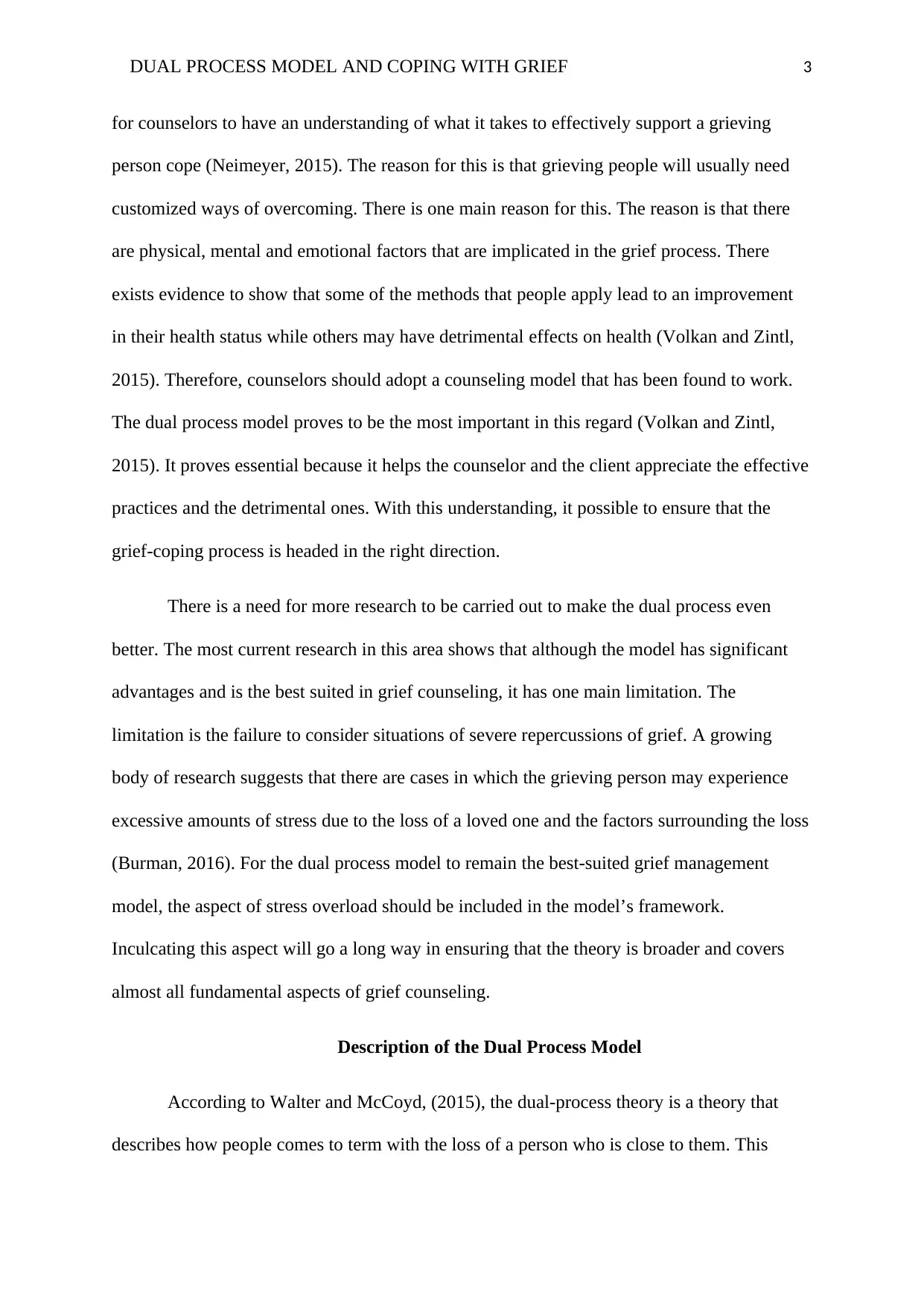
DUAL PROCESS MODEL AND COPING WITH GRIEF 3
for counselors to have an understanding of what it takes to effectively support a grieving
person cope (Neimeyer, 2015). The reason for this is that grieving people will usually need
customized ways of overcoming. There is one main reason for this. The reason is that there
are physical, mental and emotional factors that are implicated in the grief process. There
exists evidence to show that some of the methods that people apply lead to an improvement
in their health status while others may have detrimental effects on health (Volkan and Zintl,
2015). Therefore, counselors should adopt a counseling model that has been found to work.
The dual process model proves to be the most important in this regard (Volkan and Zintl,
2015). It proves essential because it helps the counselor and the client appreciate the effective
practices and the detrimental ones. With this understanding, it possible to ensure that the
grief-coping process is headed in the right direction.
There is a need for more research to be carried out to make the dual process even
better. The most current research in this area shows that although the model has significant
advantages and is the best suited in grief counseling, it has one main limitation. The
limitation is the failure to consider situations of severe repercussions of grief. A growing
body of research suggests that there are cases in which the grieving person may experience
excessive amounts of stress due to the loss of a loved one and the factors surrounding the loss
(Burman, 2016). For the dual process model to remain the best-suited grief management
model, the aspect of stress overload should be included in the model’s framework.
Inculcating this aspect will go a long way in ensuring that the theory is broader and covers
almost all fundamental aspects of grief counseling.
Description of the Dual Process Model
According to Walter and McCoyd, (2015), the dual-process theory is a theory that
describes how people comes to term with the loss of a person who is close to them. This
for counselors to have an understanding of what it takes to effectively support a grieving
person cope (Neimeyer, 2015). The reason for this is that grieving people will usually need
customized ways of overcoming. There is one main reason for this. The reason is that there
are physical, mental and emotional factors that are implicated in the grief process. There
exists evidence to show that some of the methods that people apply lead to an improvement
in their health status while others may have detrimental effects on health (Volkan and Zintl,
2015). Therefore, counselors should adopt a counseling model that has been found to work.
The dual process model proves to be the most important in this regard (Volkan and Zintl,
2015). It proves essential because it helps the counselor and the client appreciate the effective
practices and the detrimental ones. With this understanding, it possible to ensure that the
grief-coping process is headed in the right direction.
There is a need for more research to be carried out to make the dual process even
better. The most current research in this area shows that although the model has significant
advantages and is the best suited in grief counseling, it has one main limitation. The
limitation is the failure to consider situations of severe repercussions of grief. A growing
body of research suggests that there are cases in which the grieving person may experience
excessive amounts of stress due to the loss of a loved one and the factors surrounding the loss
(Burman, 2016). For the dual process model to remain the best-suited grief management
model, the aspect of stress overload should be included in the model’s framework.
Inculcating this aspect will go a long way in ensuring that the theory is broader and covers
almost all fundamental aspects of grief counseling.
Description of the Dual Process Model
According to Walter and McCoyd, (2015), the dual-process theory is a theory that
describes how people comes to term with the loss of a person who is close to them. This
⊘ This is a preview!⊘
Do you want full access?
Subscribe today to unlock all pages.

Trusted by 1+ million students worldwide
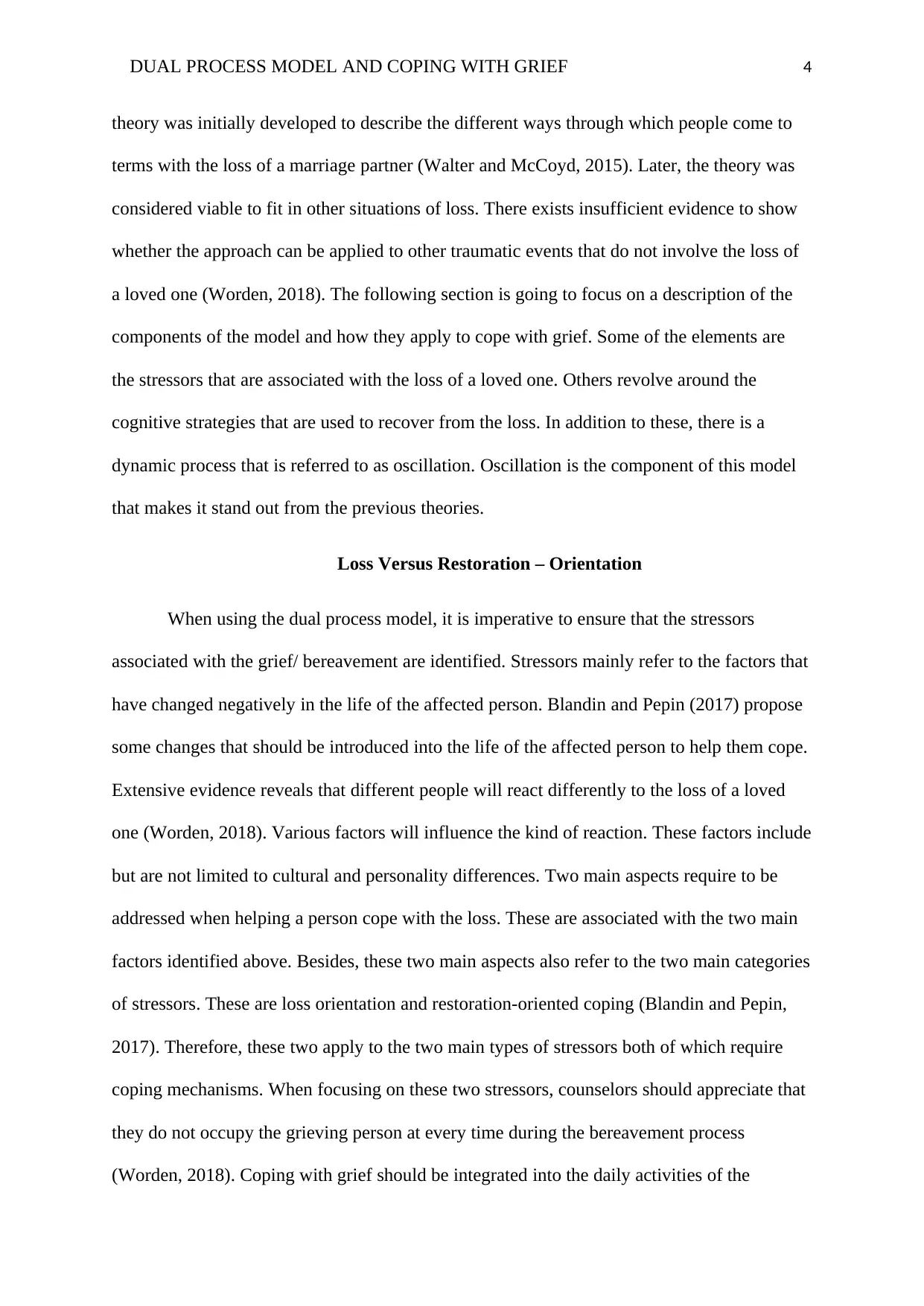
DUAL PROCESS MODEL AND COPING WITH GRIEF 4
theory was initially developed to describe the different ways through which people come to
terms with the loss of a marriage partner (Walter and McCoyd, 2015). Later, the theory was
considered viable to fit in other situations of loss. There exists insufficient evidence to show
whether the approach can be applied to other traumatic events that do not involve the loss of
a loved one (Worden, 2018). The following section is going to focus on a description of the
components of the model and how they apply to cope with grief. Some of the elements are
the stressors that are associated with the loss of a loved one. Others revolve around the
cognitive strategies that are used to recover from the loss. In addition to these, there is a
dynamic process that is referred to as oscillation. Oscillation is the component of this model
that makes it stand out from the previous theories.
Loss Versus Restoration – Orientation
When using the dual process model, it is imperative to ensure that the stressors
associated with the grief/ bereavement are identified. Stressors mainly refer to the factors that
have changed negatively in the life of the affected person. Blandin and Pepin (2017) propose
some changes that should be introduced into the life of the affected person to help them cope.
Extensive evidence reveals that different people will react differently to the loss of a loved
one (Worden, 2018). Various factors will influence the kind of reaction. These factors include
but are not limited to cultural and personality differences. Two main aspects require to be
addressed when helping a person cope with the loss. These are associated with the two main
factors identified above. Besides, these two main aspects also refer to the two main categories
of stressors. These are loss orientation and restoration-oriented coping (Blandin and Pepin,
2017). Therefore, these two apply to the two main types of stressors both of which require
coping mechanisms. When focusing on these two stressors, counselors should appreciate that
they do not occupy the grieving person at every time during the bereavement process
(Worden, 2018). Coping with grief should be integrated into the daily activities of the
theory was initially developed to describe the different ways through which people come to
terms with the loss of a marriage partner (Walter and McCoyd, 2015). Later, the theory was
considered viable to fit in other situations of loss. There exists insufficient evidence to show
whether the approach can be applied to other traumatic events that do not involve the loss of
a loved one (Worden, 2018). The following section is going to focus on a description of the
components of the model and how they apply to cope with grief. Some of the elements are
the stressors that are associated with the loss of a loved one. Others revolve around the
cognitive strategies that are used to recover from the loss. In addition to these, there is a
dynamic process that is referred to as oscillation. Oscillation is the component of this model
that makes it stand out from the previous theories.
Loss Versus Restoration – Orientation
When using the dual process model, it is imperative to ensure that the stressors
associated with the grief/ bereavement are identified. Stressors mainly refer to the factors that
have changed negatively in the life of the affected person. Blandin and Pepin (2017) propose
some changes that should be introduced into the life of the affected person to help them cope.
Extensive evidence reveals that different people will react differently to the loss of a loved
one (Worden, 2018). Various factors will influence the kind of reaction. These factors include
but are not limited to cultural and personality differences. Two main aspects require to be
addressed when helping a person cope with the loss. These are associated with the two main
factors identified above. Besides, these two main aspects also refer to the two main categories
of stressors. These are loss orientation and restoration-oriented coping (Blandin and Pepin,
2017). Therefore, these two apply to the two main types of stressors both of which require
coping mechanisms. When focusing on these two stressors, counselors should appreciate that
they do not occupy the grieving person at every time during the bereavement process
(Worden, 2018). Coping with grief should be integrated into the daily activities of the
Paraphrase This Document
Need a fresh take? Get an instant paraphrase of this document with our AI Paraphraser
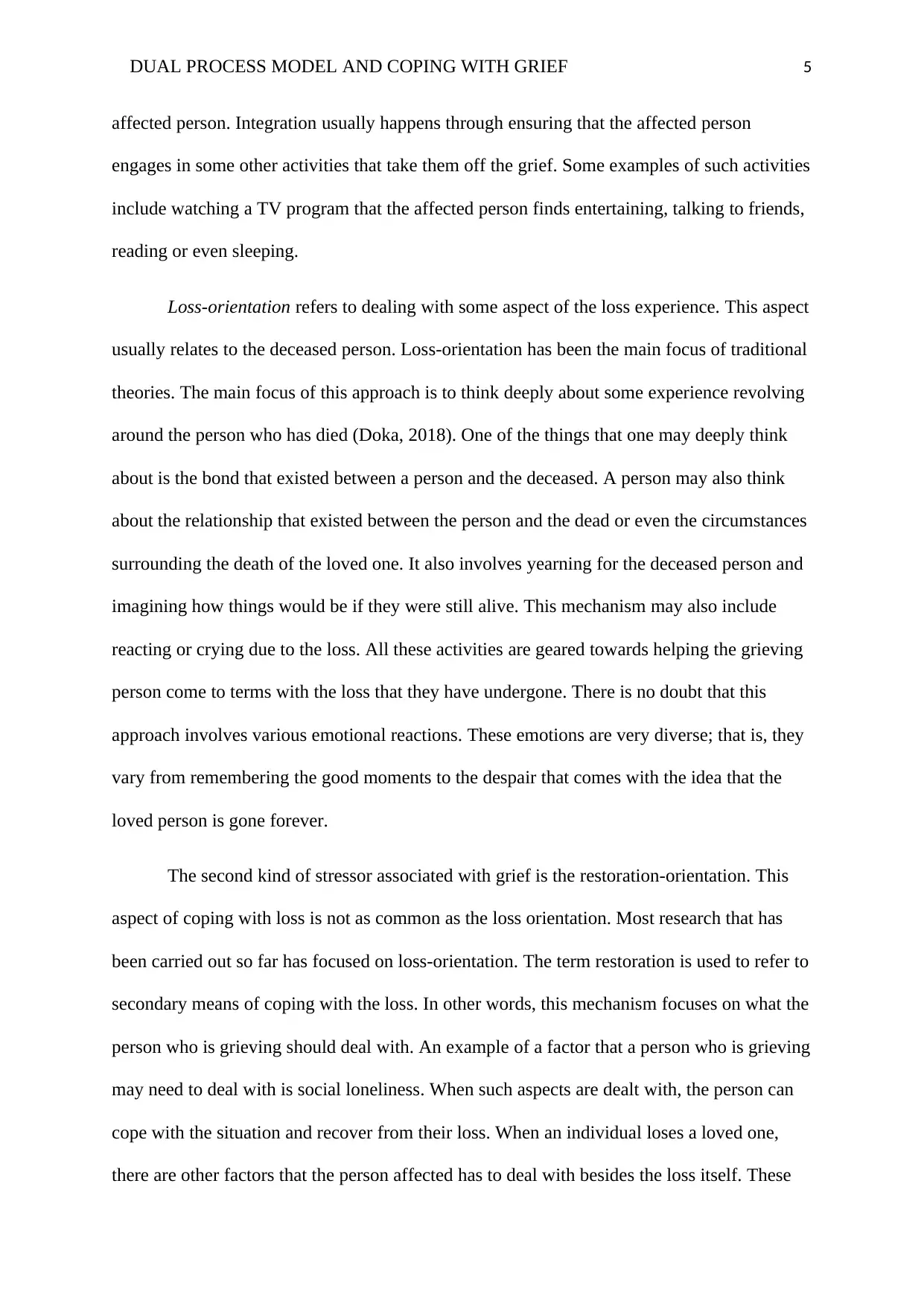
DUAL PROCESS MODEL AND COPING WITH GRIEF 5
affected person. Integration usually happens through ensuring that the affected person
engages in some other activities that take them off the grief. Some examples of such activities
include watching a TV program that the affected person finds entertaining, talking to friends,
reading or even sleeping.
Loss-orientation refers to dealing with some aspect of the loss experience. This aspect
usually relates to the deceased person. Loss-orientation has been the main focus of traditional
theories. The main focus of this approach is to think deeply about some experience revolving
around the person who has died (Doka, 2018). One of the things that one may deeply think
about is the bond that existed between a person and the deceased. A person may also think
about the relationship that existed between the person and the dead or even the circumstances
surrounding the death of the loved one. It also involves yearning for the deceased person and
imagining how things would be if they were still alive. This mechanism may also include
reacting or crying due to the loss. All these activities are geared towards helping the grieving
person come to terms with the loss that they have undergone. There is no doubt that this
approach involves various emotional reactions. These emotions are very diverse; that is, they
vary from remembering the good moments to the despair that comes with the idea that the
loved person is gone forever.
The second kind of stressor associated with grief is the restoration-orientation. This
aspect of coping with loss is not as common as the loss orientation. Most research that has
been carried out so far has focused on loss-orientation. The term restoration is used to refer to
secondary means of coping with the loss. In other words, this mechanism focuses on what the
person who is grieving should deal with. An example of a factor that a person who is grieving
may need to deal with is social loneliness. When such aspects are dealt with, the person can
cope with the situation and recover from their loss. When an individual loses a loved one,
there are other factors that the person affected has to deal with besides the loss itself. These
affected person. Integration usually happens through ensuring that the affected person
engages in some other activities that take them off the grief. Some examples of such activities
include watching a TV program that the affected person finds entertaining, talking to friends,
reading or even sleeping.
Loss-orientation refers to dealing with some aspect of the loss experience. This aspect
usually relates to the deceased person. Loss-orientation has been the main focus of traditional
theories. The main focus of this approach is to think deeply about some experience revolving
around the person who has died (Doka, 2018). One of the things that one may deeply think
about is the bond that existed between a person and the deceased. A person may also think
about the relationship that existed between the person and the dead or even the circumstances
surrounding the death of the loved one. It also involves yearning for the deceased person and
imagining how things would be if they were still alive. This mechanism may also include
reacting or crying due to the loss. All these activities are geared towards helping the grieving
person come to terms with the loss that they have undergone. There is no doubt that this
approach involves various emotional reactions. These emotions are very diverse; that is, they
vary from remembering the good moments to the despair that comes with the idea that the
loved person is gone forever.
The second kind of stressor associated with grief is the restoration-orientation. This
aspect of coping with loss is not as common as the loss orientation. Most research that has
been carried out so far has focused on loss-orientation. The term restoration is used to refer to
secondary means of coping with the loss. In other words, this mechanism focuses on what the
person who is grieving should deal with. An example of a factor that a person who is grieving
may need to deal with is social loneliness. When such aspects are dealt with, the person can
cope with the situation and recover from their loss. When an individual loses a loved one,
there are other factors that the person affected has to deal with besides the loss itself. These
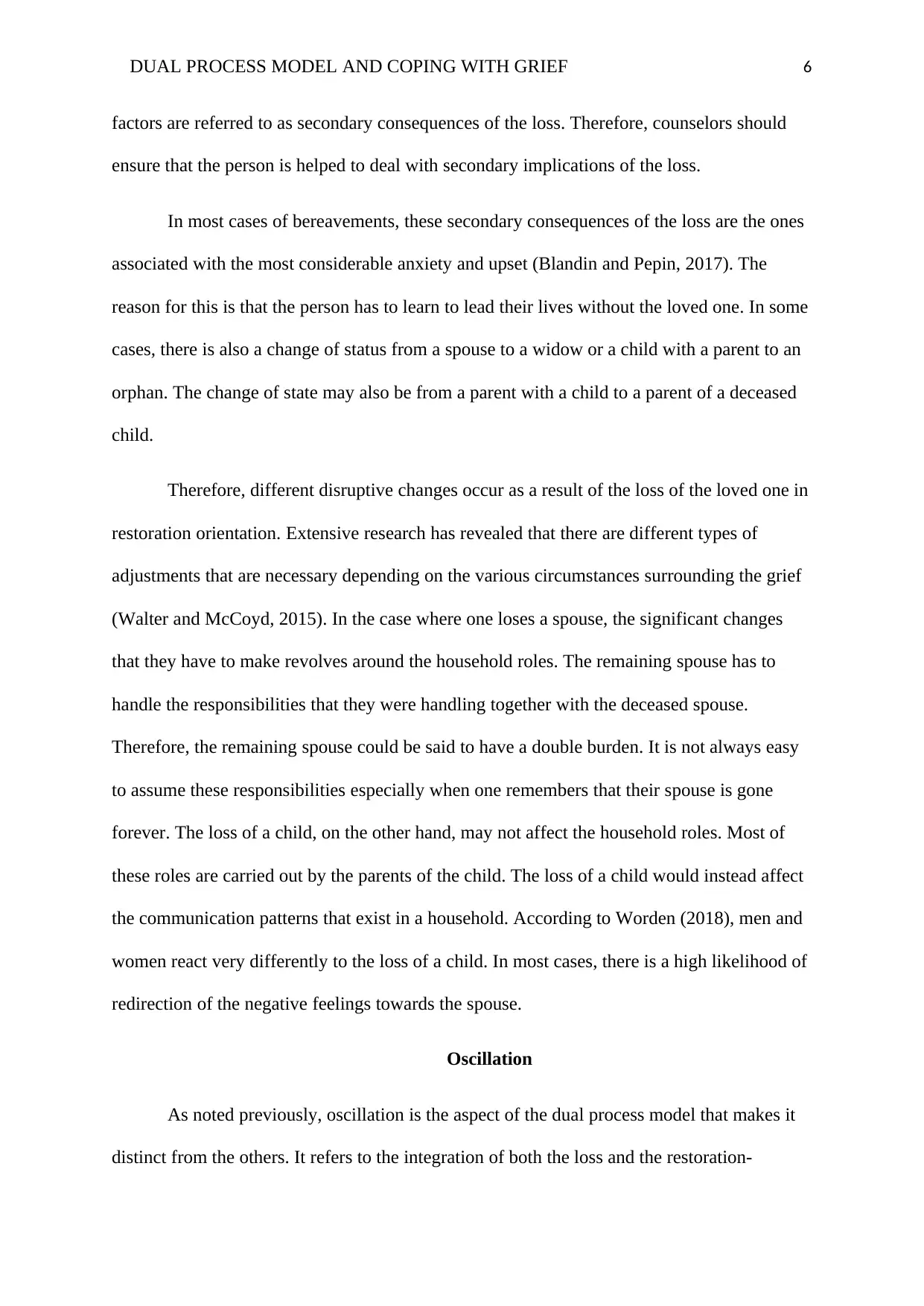
DUAL PROCESS MODEL AND COPING WITH GRIEF 6
factors are referred to as secondary consequences of the loss. Therefore, counselors should
ensure that the person is helped to deal with secondary implications of the loss.
In most cases of bereavements, these secondary consequences of the loss are the ones
associated with the most considerable anxiety and upset (Blandin and Pepin, 2017). The
reason for this is that the person has to learn to lead their lives without the loved one. In some
cases, there is also a change of status from a spouse to a widow or a child with a parent to an
orphan. The change of state may also be from a parent with a child to a parent of a deceased
child.
Therefore, different disruptive changes occur as a result of the loss of the loved one in
restoration orientation. Extensive research has revealed that there are different types of
adjustments that are necessary depending on the various circumstances surrounding the grief
(Walter and McCoyd, 2015). In the case where one loses a spouse, the significant changes
that they have to make revolves around the household roles. The remaining spouse has to
handle the responsibilities that they were handling together with the deceased spouse.
Therefore, the remaining spouse could be said to have a double burden. It is not always easy
to assume these responsibilities especially when one remembers that their spouse is gone
forever. The loss of a child, on the other hand, may not affect the household roles. Most of
these roles are carried out by the parents of the child. The loss of a child would instead affect
the communication patterns that exist in a household. According to Worden (2018), men and
women react very differently to the loss of a child. In most cases, there is a high likelihood of
redirection of the negative feelings towards the spouse.
Oscillation
As noted previously, oscillation is the aspect of the dual process model that makes it
distinct from the others. It refers to the integration of both the loss and the restoration-
factors are referred to as secondary consequences of the loss. Therefore, counselors should
ensure that the person is helped to deal with secondary implications of the loss.
In most cases of bereavements, these secondary consequences of the loss are the ones
associated with the most considerable anxiety and upset (Blandin and Pepin, 2017). The
reason for this is that the person has to learn to lead their lives without the loved one. In some
cases, there is also a change of status from a spouse to a widow or a child with a parent to an
orphan. The change of state may also be from a parent with a child to a parent of a deceased
child.
Therefore, different disruptive changes occur as a result of the loss of the loved one in
restoration orientation. Extensive research has revealed that there are different types of
adjustments that are necessary depending on the various circumstances surrounding the grief
(Walter and McCoyd, 2015). In the case where one loses a spouse, the significant changes
that they have to make revolves around the household roles. The remaining spouse has to
handle the responsibilities that they were handling together with the deceased spouse.
Therefore, the remaining spouse could be said to have a double burden. It is not always easy
to assume these responsibilities especially when one remembers that their spouse is gone
forever. The loss of a child, on the other hand, may not affect the household roles. Most of
these roles are carried out by the parents of the child. The loss of a child would instead affect
the communication patterns that exist in a household. According to Worden (2018), men and
women react very differently to the loss of a child. In most cases, there is a high likelihood of
redirection of the negative feelings towards the spouse.
Oscillation
As noted previously, oscillation is the aspect of the dual process model that makes it
distinct from the others. It refers to the integration of both the loss and the restoration-
⊘ This is a preview!⊘
Do you want full access?
Subscribe today to unlock all pages.

Trusted by 1+ million students worldwide
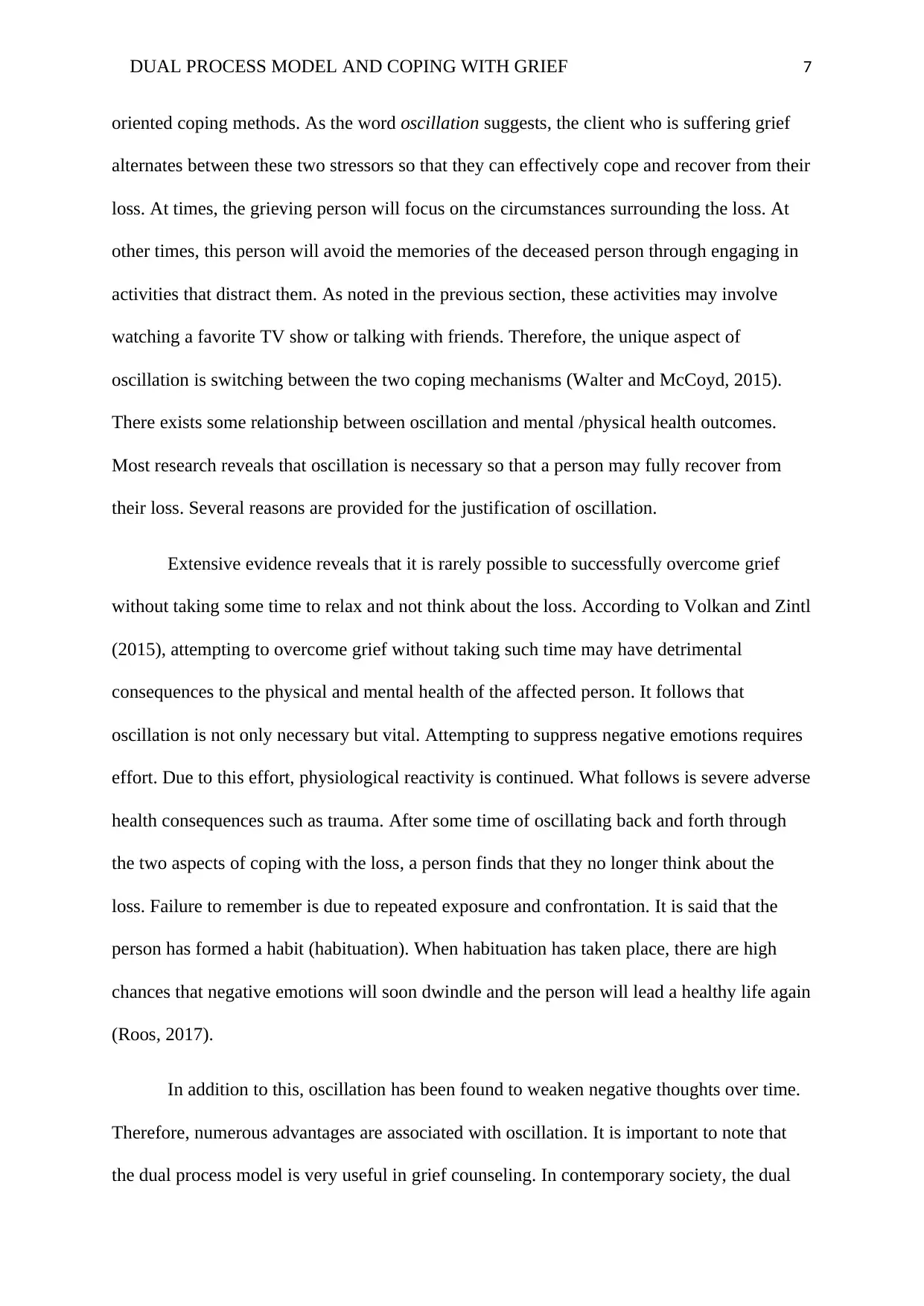
DUAL PROCESS MODEL AND COPING WITH GRIEF 7
oriented coping methods. As the word oscillation suggests, the client who is suffering grief
alternates between these two stressors so that they can effectively cope and recover from their
loss. At times, the grieving person will focus on the circumstances surrounding the loss. At
other times, this person will avoid the memories of the deceased person through engaging in
activities that distract them. As noted in the previous section, these activities may involve
watching a favorite TV show or talking with friends. Therefore, the unique aspect of
oscillation is switching between the two coping mechanisms (Walter and McCoyd, 2015).
There exists some relationship between oscillation and mental /physical health outcomes.
Most research reveals that oscillation is necessary so that a person may fully recover from
their loss. Several reasons are provided for the justification of oscillation.
Extensive evidence reveals that it is rarely possible to successfully overcome grief
without taking some time to relax and not think about the loss. According to Volkan and Zintl
(2015), attempting to overcome grief without taking such time may have detrimental
consequences to the physical and mental health of the affected person. It follows that
oscillation is not only necessary but vital. Attempting to suppress negative emotions requires
effort. Due to this effort, physiological reactivity is continued. What follows is severe adverse
health consequences such as trauma. After some time of oscillating back and forth through
the two aspects of coping with the loss, a person finds that they no longer think about the
loss. Failure to remember is due to repeated exposure and confrontation. It is said that the
person has formed a habit (habituation). When habituation has taken place, there are high
chances that negative emotions will soon dwindle and the person will lead a healthy life again
(Roos, 2017).
In addition to this, oscillation has been found to weaken negative thoughts over time.
Therefore, numerous advantages are associated with oscillation. It is important to note that
the dual process model is very useful in grief counseling. In contemporary society, the dual
oriented coping methods. As the word oscillation suggests, the client who is suffering grief
alternates between these two stressors so that they can effectively cope and recover from their
loss. At times, the grieving person will focus on the circumstances surrounding the loss. At
other times, this person will avoid the memories of the deceased person through engaging in
activities that distract them. As noted in the previous section, these activities may involve
watching a favorite TV show or talking with friends. Therefore, the unique aspect of
oscillation is switching between the two coping mechanisms (Walter and McCoyd, 2015).
There exists some relationship between oscillation and mental /physical health outcomes.
Most research reveals that oscillation is necessary so that a person may fully recover from
their loss. Several reasons are provided for the justification of oscillation.
Extensive evidence reveals that it is rarely possible to successfully overcome grief
without taking some time to relax and not think about the loss. According to Volkan and Zintl
(2015), attempting to overcome grief without taking such time may have detrimental
consequences to the physical and mental health of the affected person. It follows that
oscillation is not only necessary but vital. Attempting to suppress negative emotions requires
effort. Due to this effort, physiological reactivity is continued. What follows is severe adverse
health consequences such as trauma. After some time of oscillating back and forth through
the two aspects of coping with the loss, a person finds that they no longer think about the
loss. Failure to remember is due to repeated exposure and confrontation. It is said that the
person has formed a habit (habituation). When habituation has taken place, there are high
chances that negative emotions will soon dwindle and the person will lead a healthy life again
(Roos, 2017).
In addition to this, oscillation has been found to weaken negative thoughts over time.
Therefore, numerous advantages are associated with oscillation. It is important to note that
the dual process model is very useful in grief counseling. In contemporary society, the dual
Paraphrase This Document
Need a fresh take? Get an instant paraphrase of this document with our AI Paraphraser
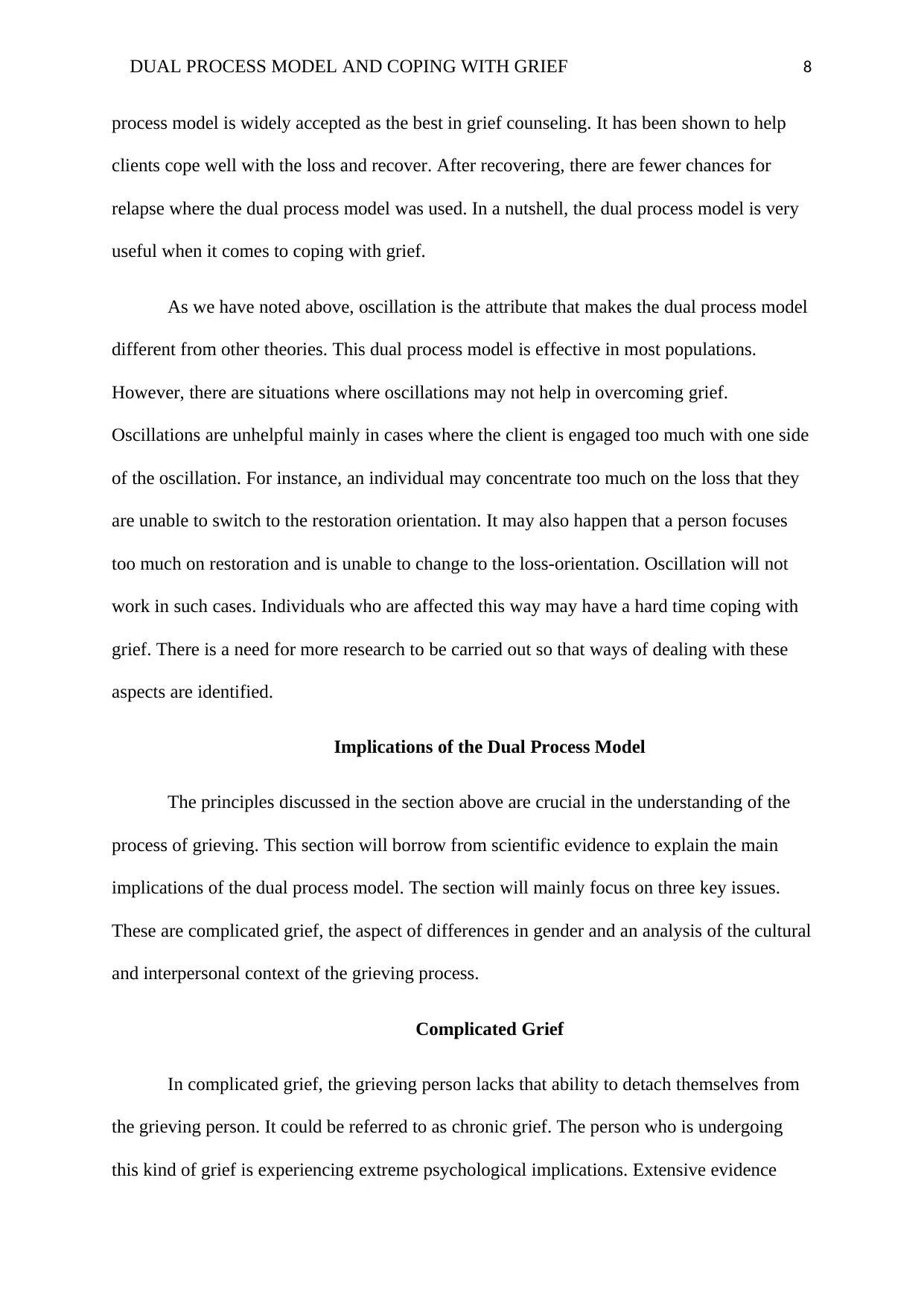
DUAL PROCESS MODEL AND COPING WITH GRIEF 8
process model is widely accepted as the best in grief counseling. It has been shown to help
clients cope well with the loss and recover. After recovering, there are fewer chances for
relapse where the dual process model was used. In a nutshell, the dual process model is very
useful when it comes to coping with grief.
As we have noted above, oscillation is the attribute that makes the dual process model
different from other theories. This dual process model is effective in most populations.
However, there are situations where oscillations may not help in overcoming grief.
Oscillations are unhelpful mainly in cases where the client is engaged too much with one side
of the oscillation. For instance, an individual may concentrate too much on the loss that they
are unable to switch to the restoration orientation. It may also happen that a person focuses
too much on restoration and is unable to change to the loss-orientation. Oscillation will not
work in such cases. Individuals who are affected this way may have a hard time coping with
grief. There is a need for more research to be carried out so that ways of dealing with these
aspects are identified.
Implications of the Dual Process Model
The principles discussed in the section above are crucial in the understanding of the
process of grieving. This section will borrow from scientific evidence to explain the main
implications of the dual process model. The section will mainly focus on three key issues.
These are complicated grief, the aspect of differences in gender and an analysis of the cultural
and interpersonal context of the grieving process.
Complicated Grief
In complicated grief, the grieving person lacks that ability to detach themselves from
the grieving person. It could be referred to as chronic grief. The person who is undergoing
this kind of grief is experiencing extreme psychological implications. Extensive evidence
process model is widely accepted as the best in grief counseling. It has been shown to help
clients cope well with the loss and recover. After recovering, there are fewer chances for
relapse where the dual process model was used. In a nutshell, the dual process model is very
useful when it comes to coping with grief.
As we have noted above, oscillation is the attribute that makes the dual process model
different from other theories. This dual process model is effective in most populations.
However, there are situations where oscillations may not help in overcoming grief.
Oscillations are unhelpful mainly in cases where the client is engaged too much with one side
of the oscillation. For instance, an individual may concentrate too much on the loss that they
are unable to switch to the restoration orientation. It may also happen that a person focuses
too much on restoration and is unable to change to the loss-orientation. Oscillation will not
work in such cases. Individuals who are affected this way may have a hard time coping with
grief. There is a need for more research to be carried out so that ways of dealing with these
aspects are identified.
Implications of the Dual Process Model
The principles discussed in the section above are crucial in the understanding of the
process of grieving. This section will borrow from scientific evidence to explain the main
implications of the dual process model. The section will mainly focus on three key issues.
These are complicated grief, the aspect of differences in gender and an analysis of the cultural
and interpersonal context of the grieving process.
Complicated Grief
In complicated grief, the grieving person lacks that ability to detach themselves from
the grieving person. It could be referred to as chronic grief. The person who is undergoing
this kind of grief is experiencing extreme psychological implications. Extensive evidence

DUAL PROCESS MODEL AND COPING WITH GRIEF 9
reveals that this chronic grief may lead to conditions such as depression and trauma (Volkan
and Zintl, 2015). The grieving person also experiences what is referred to as a confrontation.
Confrontation refers to a situation where a person tries to act or behave as if nothing is
happening. Due to this confrontation, an individual may endeavor to ensure that they lead
healthy lives at work, talk generally to a friend, etc. This usually a mechanism of convincing
oneself that nothing happened. Researchers typically consider this to be a problem of
oscillation. In such a case, the individual cannot switch in between confrontation and
avoidance which makes it very hard for the appropriate adjustment to occur.
There are some cases where the person may experience extreme avoidance of reality.
At this stage, overcoming grief is not an easy process. The dual process model has been
found to significantly help such people overcome their grief (Volkan and Zintl, 2015).
Research reveals that the traditional theories were limiting for they could not provide
practical ways of dealing with such situations. Traditional theories are limited because the
circumstances of grief are different for each person. Besides, the factors that are involved in
the grieving process would be described as multifaceted. Employing the dual process model
has been shown to help the affected person to slowly but surely recover from complicated
grief. The counselor using the dual process model endeavors to ensure that the client is
supported to use the process of oscillation effectively. Once, the client has been able to
become stable and use the procedure of oscillation appropriately, then the healing process has
already started.
There are some standard features of complicated grief. One of the most important is
that the people who undergo it usually have experienced a traumatic loss. Therefore, post-
traumatic stress is typically apparent in most cases of complicated grief. If we were to use the
dual process model to explain what brings about the traumatic loss, we would conclude that it
is merely the disturbance of the process of oscillation. In this kind of grief, a person
reveals that this chronic grief may lead to conditions such as depression and trauma (Volkan
and Zintl, 2015). The grieving person also experiences what is referred to as a confrontation.
Confrontation refers to a situation where a person tries to act or behave as if nothing is
happening. Due to this confrontation, an individual may endeavor to ensure that they lead
healthy lives at work, talk generally to a friend, etc. This usually a mechanism of convincing
oneself that nothing happened. Researchers typically consider this to be a problem of
oscillation. In such a case, the individual cannot switch in between confrontation and
avoidance which makes it very hard for the appropriate adjustment to occur.
There are some cases where the person may experience extreme avoidance of reality.
At this stage, overcoming grief is not an easy process. The dual process model has been
found to significantly help such people overcome their grief (Volkan and Zintl, 2015).
Research reveals that the traditional theories were limiting for they could not provide
practical ways of dealing with such situations. Traditional theories are limited because the
circumstances of grief are different for each person. Besides, the factors that are involved in
the grieving process would be described as multifaceted. Employing the dual process model
has been shown to help the affected person to slowly but surely recover from complicated
grief. The counselor using the dual process model endeavors to ensure that the client is
supported to use the process of oscillation effectively. Once, the client has been able to
become stable and use the procedure of oscillation appropriately, then the healing process has
already started.
There are some standard features of complicated grief. One of the most important is
that the people who undergo it usually have experienced a traumatic loss. Therefore, post-
traumatic stress is typically apparent in most cases of complicated grief. If we were to use the
dual process model to explain what brings about the traumatic loss, we would conclude that it
is merely the disturbance of the process of oscillation. In this kind of grief, a person
⊘ This is a preview!⊘
Do you want full access?
Subscribe today to unlock all pages.

Trusted by 1+ million students worldwide
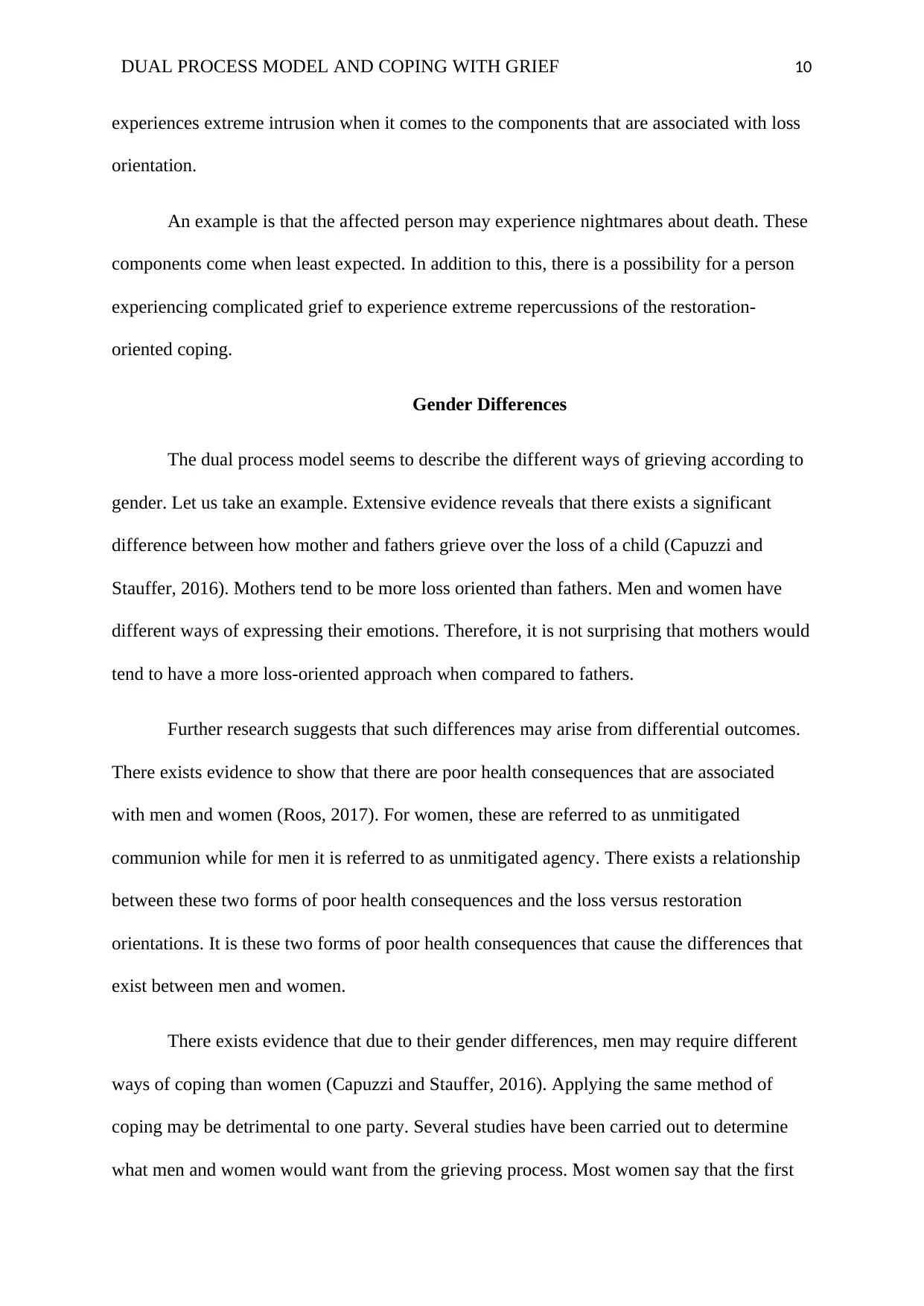
DUAL PROCESS MODEL AND COPING WITH GRIEF 10
experiences extreme intrusion when it comes to the components that are associated with loss
orientation.
An example is that the affected person may experience nightmares about death. These
components come when least expected. In addition to this, there is a possibility for a person
experiencing complicated grief to experience extreme repercussions of the restoration-
oriented coping.
Gender Differences
The dual process model seems to describe the different ways of grieving according to
gender. Let us take an example. Extensive evidence reveals that there exists a significant
difference between how mother and fathers grieve over the loss of a child (Capuzzi and
Stauffer, 2016). Mothers tend to be more loss oriented than fathers. Men and women have
different ways of expressing their emotions. Therefore, it is not surprising that mothers would
tend to have a more loss-oriented approach when compared to fathers.
Further research suggests that such differences may arise from differential outcomes.
There exists evidence to show that there are poor health consequences that are associated
with men and women (Roos, 2017). For women, these are referred to as unmitigated
communion while for men it is referred to as unmitigated agency. There exists a relationship
between these two forms of poor health consequences and the loss versus restoration
orientations. It is these two forms of poor health consequences that cause the differences that
exist between men and women.
There exists evidence that due to their gender differences, men may require different
ways of coping than women (Capuzzi and Stauffer, 2016). Applying the same method of
coping may be detrimental to one party. Several studies have been carried out to determine
what men and women would want from the grieving process. Most women say that the first
experiences extreme intrusion when it comes to the components that are associated with loss
orientation.
An example is that the affected person may experience nightmares about death. These
components come when least expected. In addition to this, there is a possibility for a person
experiencing complicated grief to experience extreme repercussions of the restoration-
oriented coping.
Gender Differences
The dual process model seems to describe the different ways of grieving according to
gender. Let us take an example. Extensive evidence reveals that there exists a significant
difference between how mother and fathers grieve over the loss of a child (Capuzzi and
Stauffer, 2016). Mothers tend to be more loss oriented than fathers. Men and women have
different ways of expressing their emotions. Therefore, it is not surprising that mothers would
tend to have a more loss-oriented approach when compared to fathers.
Further research suggests that such differences may arise from differential outcomes.
There exists evidence to show that there are poor health consequences that are associated
with men and women (Roos, 2017). For women, these are referred to as unmitigated
communion while for men it is referred to as unmitigated agency. There exists a relationship
between these two forms of poor health consequences and the loss versus restoration
orientations. It is these two forms of poor health consequences that cause the differences that
exist between men and women.
There exists evidence that due to their gender differences, men may require different
ways of coping than women (Capuzzi and Stauffer, 2016). Applying the same method of
coping may be detrimental to one party. Several studies have been carried out to determine
what men and women would want from the grieving process. Most women say that the first
Paraphrase This Document
Need a fresh take? Get an instant paraphrase of this document with our AI Paraphraser
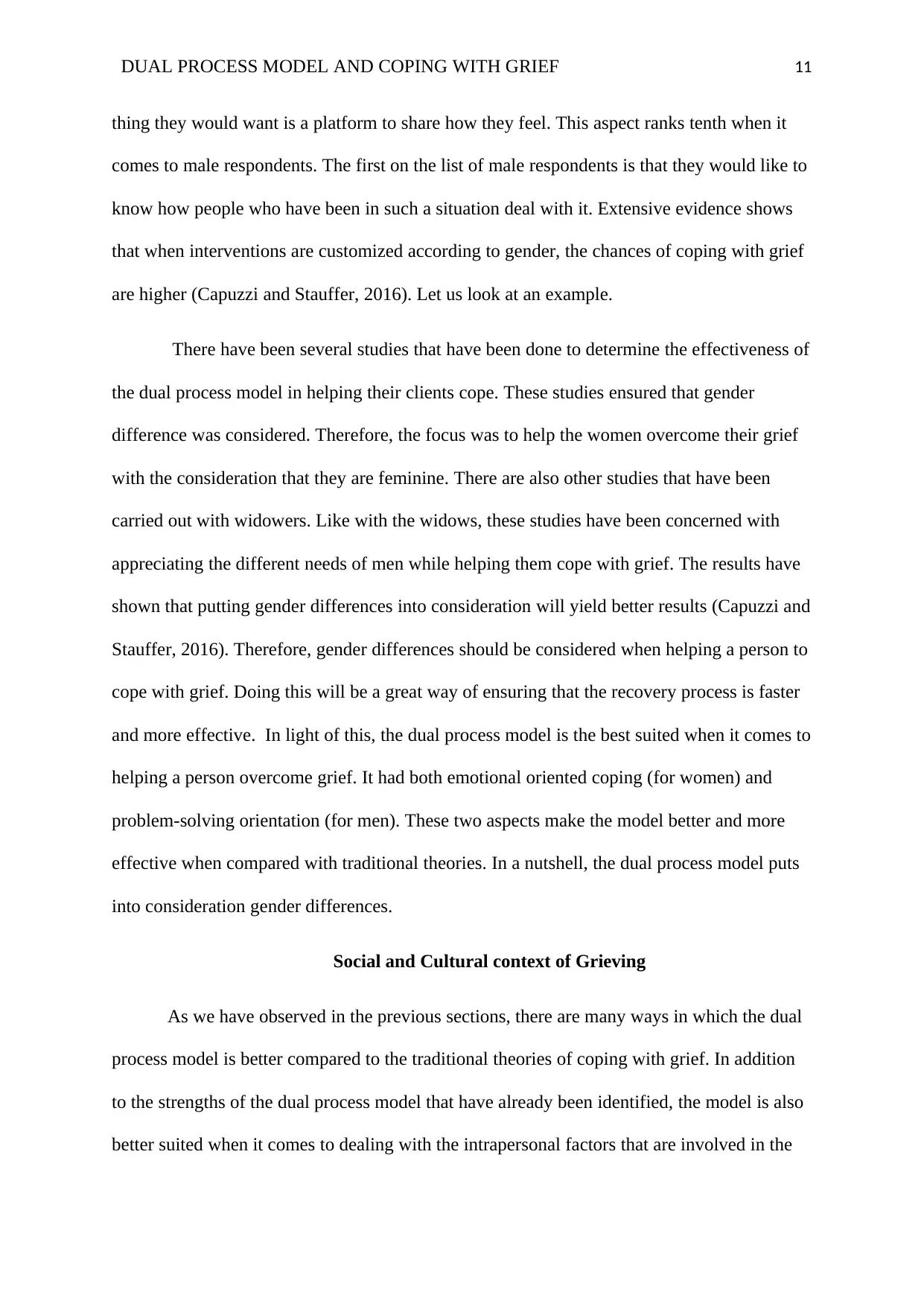
DUAL PROCESS MODEL AND COPING WITH GRIEF 11
thing they would want is a platform to share how they feel. This aspect ranks tenth when it
comes to male respondents. The first on the list of male respondents is that they would like to
know how people who have been in such a situation deal with it. Extensive evidence shows
that when interventions are customized according to gender, the chances of coping with grief
are higher (Capuzzi and Stauffer, 2016). Let us look at an example.
There have been several studies that have been done to determine the effectiveness of
the dual process model in helping their clients cope. These studies ensured that gender
difference was considered. Therefore, the focus was to help the women overcome their grief
with the consideration that they are feminine. There are also other studies that have been
carried out with widowers. Like with the widows, these studies have been concerned with
appreciating the different needs of men while helping them cope with grief. The results have
shown that putting gender differences into consideration will yield better results (Capuzzi and
Stauffer, 2016). Therefore, gender differences should be considered when helping a person to
cope with grief. Doing this will be a great way of ensuring that the recovery process is faster
and more effective. In light of this, the dual process model is the best suited when it comes to
helping a person overcome grief. It had both emotional oriented coping (for women) and
problem-solving orientation (for men). These two aspects make the model better and more
effective when compared with traditional theories. In a nutshell, the dual process model puts
into consideration gender differences.
Social and Cultural context of Grieving
As we have observed in the previous sections, there are many ways in which the dual
process model is better compared to the traditional theories of coping with grief. In addition
to the strengths of the dual process model that have already been identified, the model is also
better suited when it comes to dealing with the intrapersonal factors that are involved in the
thing they would want is a platform to share how they feel. This aspect ranks tenth when it
comes to male respondents. The first on the list of male respondents is that they would like to
know how people who have been in such a situation deal with it. Extensive evidence shows
that when interventions are customized according to gender, the chances of coping with grief
are higher (Capuzzi and Stauffer, 2016). Let us look at an example.
There have been several studies that have been done to determine the effectiveness of
the dual process model in helping their clients cope. These studies ensured that gender
difference was considered. Therefore, the focus was to help the women overcome their grief
with the consideration that they are feminine. There are also other studies that have been
carried out with widowers. Like with the widows, these studies have been concerned with
appreciating the different needs of men while helping them cope with grief. The results have
shown that putting gender differences into consideration will yield better results (Capuzzi and
Stauffer, 2016). Therefore, gender differences should be considered when helping a person to
cope with grief. Doing this will be a great way of ensuring that the recovery process is faster
and more effective. In light of this, the dual process model is the best suited when it comes to
helping a person overcome grief. It had both emotional oriented coping (for women) and
problem-solving orientation (for men). These two aspects make the model better and more
effective when compared with traditional theories. In a nutshell, the dual process model puts
into consideration gender differences.
Social and Cultural context of Grieving
As we have observed in the previous sections, there are many ways in which the dual
process model is better compared to the traditional theories of coping with grief. In addition
to the strengths of the dual process model that have already been identified, the model is also
better suited when it comes to dealing with the intrapersonal factors that are involved in the
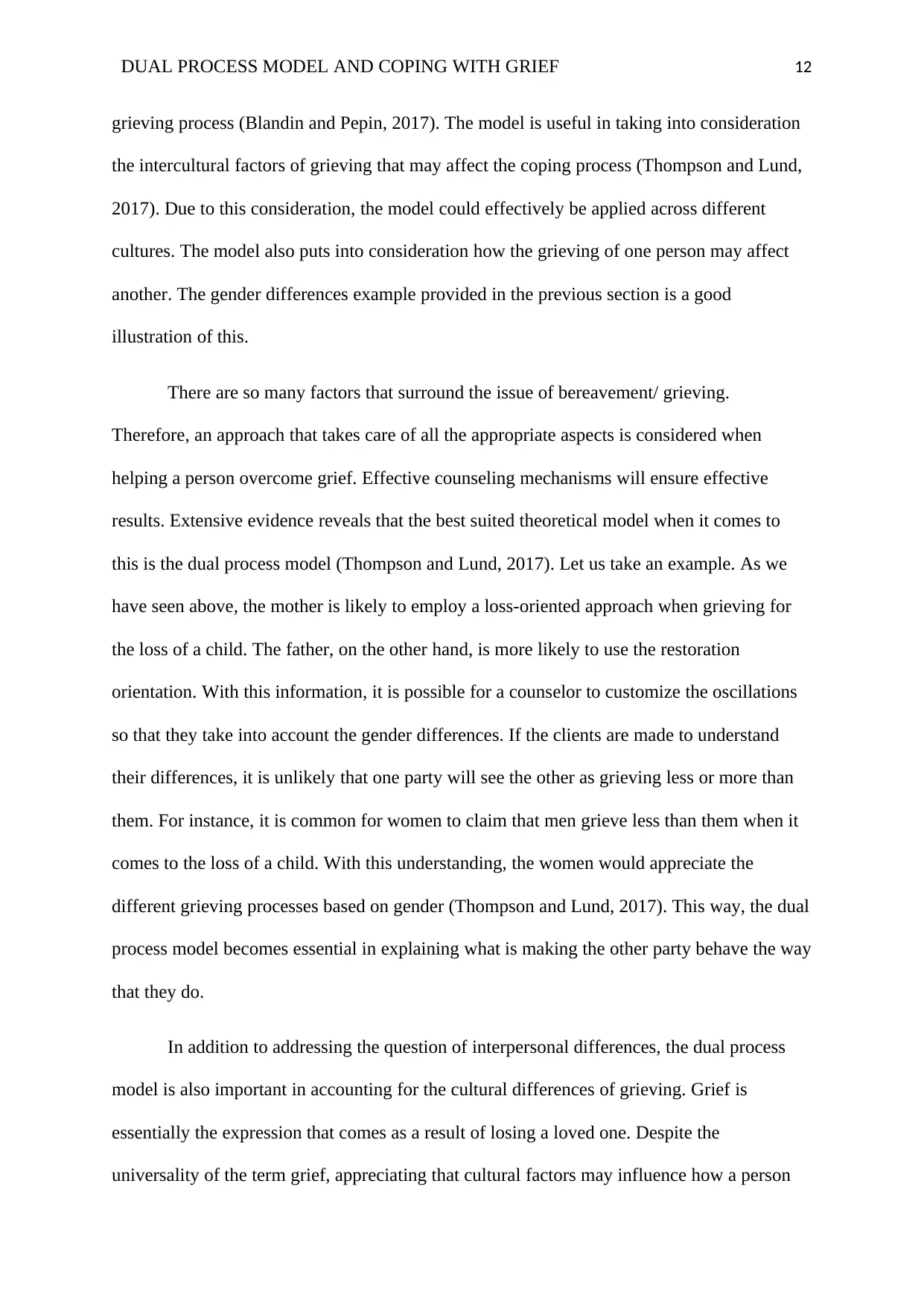
DUAL PROCESS MODEL AND COPING WITH GRIEF 12
grieving process (Blandin and Pepin, 2017). The model is useful in taking into consideration
the intercultural factors of grieving that may affect the coping process (Thompson and Lund,
2017). Due to this consideration, the model could effectively be applied across different
cultures. The model also puts into consideration how the grieving of one person may affect
another. The gender differences example provided in the previous section is a good
illustration of this.
There are so many factors that surround the issue of bereavement/ grieving.
Therefore, an approach that takes care of all the appropriate aspects is considered when
helping a person overcome grief. Effective counseling mechanisms will ensure effective
results. Extensive evidence reveals that the best suited theoretical model when it comes to
this is the dual process model (Thompson and Lund, 2017). Let us take an example. As we
have seen above, the mother is likely to employ a loss-oriented approach when grieving for
the loss of a child. The father, on the other hand, is more likely to use the restoration
orientation. With this information, it is possible for a counselor to customize the oscillations
so that they take into account the gender differences. If the clients are made to understand
their differences, it is unlikely that one party will see the other as grieving less or more than
them. For instance, it is common for women to claim that men grieve less than them when it
comes to the loss of a child. With this understanding, the women would appreciate the
different grieving processes based on gender (Thompson and Lund, 2017). This way, the dual
process model becomes essential in explaining what is making the other party behave the way
that they do.
In addition to addressing the question of interpersonal differences, the dual process
model is also important in accounting for the cultural differences of grieving. Grief is
essentially the expression that comes as a result of losing a loved one. Despite the
universality of the term grief, appreciating that cultural factors may influence how a person
grieving process (Blandin and Pepin, 2017). The model is useful in taking into consideration
the intercultural factors of grieving that may affect the coping process (Thompson and Lund,
2017). Due to this consideration, the model could effectively be applied across different
cultures. The model also puts into consideration how the grieving of one person may affect
another. The gender differences example provided in the previous section is a good
illustration of this.
There are so many factors that surround the issue of bereavement/ grieving.
Therefore, an approach that takes care of all the appropriate aspects is considered when
helping a person overcome grief. Effective counseling mechanisms will ensure effective
results. Extensive evidence reveals that the best suited theoretical model when it comes to
this is the dual process model (Thompson and Lund, 2017). Let us take an example. As we
have seen above, the mother is likely to employ a loss-oriented approach when grieving for
the loss of a child. The father, on the other hand, is more likely to use the restoration
orientation. With this information, it is possible for a counselor to customize the oscillations
so that they take into account the gender differences. If the clients are made to understand
their differences, it is unlikely that one party will see the other as grieving less or more than
them. For instance, it is common for women to claim that men grieve less than them when it
comes to the loss of a child. With this understanding, the women would appreciate the
different grieving processes based on gender (Thompson and Lund, 2017). This way, the dual
process model becomes essential in explaining what is making the other party behave the way
that they do.
In addition to addressing the question of interpersonal differences, the dual process
model is also important in accounting for the cultural differences of grieving. Grief is
essentially the expression that comes as a result of losing a loved one. Despite the
universality of the term grief, appreciating that cultural factors may influence how a person
⊘ This is a preview!⊘
Do you want full access?
Subscribe today to unlock all pages.

Trusted by 1+ million students worldwide
1 out of 23
Your All-in-One AI-Powered Toolkit for Academic Success.
+13062052269
info@desklib.com
Available 24*7 on WhatsApp / Email
![[object Object]](/_next/static/media/star-bottom.7253800d.svg)
Unlock your academic potential
Copyright © 2020–2025 A2Z Services. All Rights Reserved. Developed and managed by ZUCOL.


